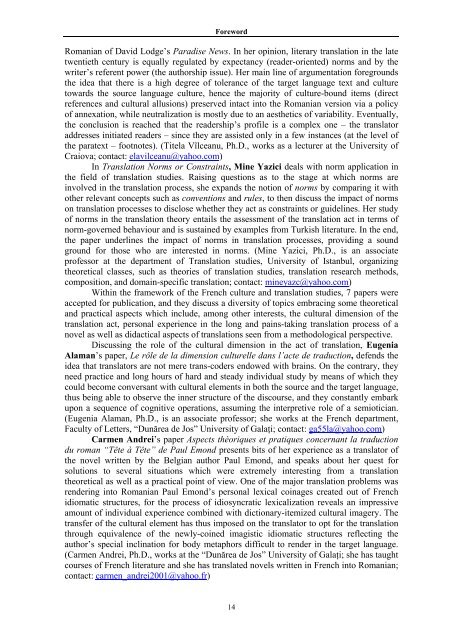translation studies - Facultatea de Litere - Dunarea de Jos
translation studies - Facultatea de Litere - Dunarea de Jos
translation studies - Facultatea de Litere - Dunarea de Jos
Create successful ePaper yourself
Turn your PDF publications into a flip-book with our unique Google optimized e-Paper software.
Foreword<br />
Romanian of David Lodge’s Paradise News. In her opinion, literary <strong>translation</strong> in the late<br />
twentieth century is equally regulated by expectancy (rea<strong>de</strong>r-oriented) norms and by the<br />
writer’s referent power (the authorship issue). Her main line of argumentation foregrounds<br />
the i<strong>de</strong>a that there is a high <strong>de</strong>gree of tolerance of the target language text and culture<br />
towards the source language culture, hence the majority of culture-bound items (direct<br />
references and cultural allusions) preserved intact into the Romanian version via a policy<br />
of annexation, while neutralization is mostly due to an aesthetics of variability. Eventually,<br />
the conclusion is reached that the rea<strong>de</strong>rship’s profile is a complex one – the translator<br />
addresses initiated rea<strong>de</strong>rs – since they are assisted only in a few instances (at the level of<br />
the paratext – footnotes). (Titela Vîlceanu, Ph.D., works as a lecturer at the University of<br />
Craiova; contact: elavilceanu@yahoo.com)<br />
In Translation Norms or Constraints, Mine Yazici <strong>de</strong>als with norm application in<br />
the field of <strong>translation</strong> <strong>studies</strong>. Raising questions as to the stage at which norms are<br />
involved in the <strong>translation</strong> process, she expands the notion of norms by comparing it with<br />
other relevant concepts such as conventions and rules, to then discuss the impact of norms<br />
on <strong>translation</strong> processes to disclose whether they act as constraints or gui<strong>de</strong>lines. Her study<br />
of norms in the <strong>translation</strong> theory entails the assessment of the <strong>translation</strong> act in terms of<br />
norm-governed behaviour and is sustained by examples from Turkish literature. In the end,<br />
the paper un<strong>de</strong>rlines the impact of norms in <strong>translation</strong> processes, providing a sound<br />
ground for those who are interested in norms. (Mine Yazici, Ph.D., is an associate<br />
professor at the <strong>de</strong>partment of Translation <strong>studies</strong>, University of Istanbul, organizing<br />
theoretical classes, such as theories of <strong>translation</strong> <strong>studies</strong>, <strong>translation</strong> research methods,<br />
composition, and domain-specific <strong>translation</strong>; contact: mineyazc@yahoo.com)<br />
Within the framework of the French culture and <strong>translation</strong> <strong>studies</strong>, 7 papers were<br />
accepted for publication, and they discuss a diversity of topics embracing some theoretical<br />
and practical aspects which inclu<strong>de</strong>, among other interests, the cultural dimension of the<br />
<strong>translation</strong> act, personal experience in the long and pains-taking <strong>translation</strong> process of a<br />
novel as well as didactical aspects of <strong>translation</strong>s seen from a methodological perspective.<br />
Discussing the role of the cultural dimension in the act of <strong>translation</strong>, Eugenia<br />
Alaman’s paper, Le rôle <strong>de</strong> la dimension culturelle dans l’acte <strong>de</strong> traduction, <strong>de</strong>fends the<br />
i<strong>de</strong>a that translators are not mere trans-co<strong>de</strong>rs endowed with brains. On the contrary, they<br />
need practice and long hours of hard and steady individual study by means of which they<br />
could become conversant with cultural elements in both the source and the target language,<br />
thus being able to observe the inner structure of the discourse, and they constantly embark<br />
upon a sequence of cognitive operations, assuming the interpretive role of a semiotician.<br />
(Eugenia Alaman, Ph.D., is an associate professor; she works at the French <strong>de</strong>partment,<br />
Faculty of Letters, “Dunărea <strong>de</strong> <strong>Jos</strong>” University of Galaţi; contact: ga55la@yahoo.com)<br />
Carmen Andrei’s paper Aspects théoriques et pratiques concernant la traduction<br />
du roman “Tête à Tête” <strong>de</strong> Paul Emond presents bits of her experience as a translator of<br />
the novel written by the Belgian author Paul Emond, and speaks about her quest for<br />
solutions to several situations which were extremely interesting from a <strong>translation</strong><br />
theoretical as well as a practical point of view. One of the major <strong>translation</strong> problems was<br />
ren<strong>de</strong>ring into Romanian Paul Emond’s personal lexical coinages created out of French<br />
idiomatic structures, for the process of idiosyncratic lexicalization reveals an impressive<br />
amount of individual experience combined with dictionary-itemized cultural imagery. The<br />
transfer of the cultural element has thus imposed on the translator to opt for the <strong>translation</strong><br />
through equivalence of the newly-coined imagistic idiomatic structures reflecting the<br />
author’s special inclination for body metaphors difficult to ren<strong>de</strong>r in the target language.<br />
(Carmen Andrei, Ph.D., works at the “Dunărea <strong>de</strong> <strong>Jos</strong>” University of Galaţi; she has taught<br />
courses of French literature and she has translated novels written in French into Romanian;<br />
contact: carmen_andrei2001@yahoo.fr)<br />
14












